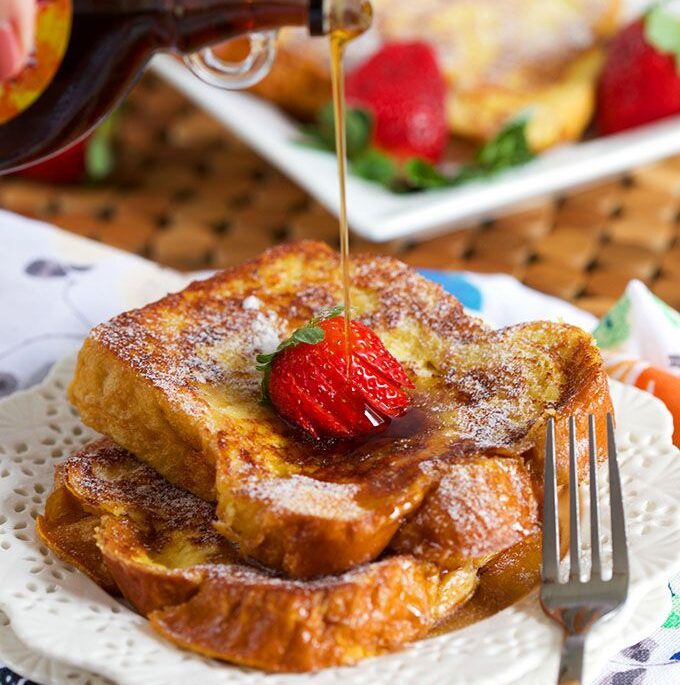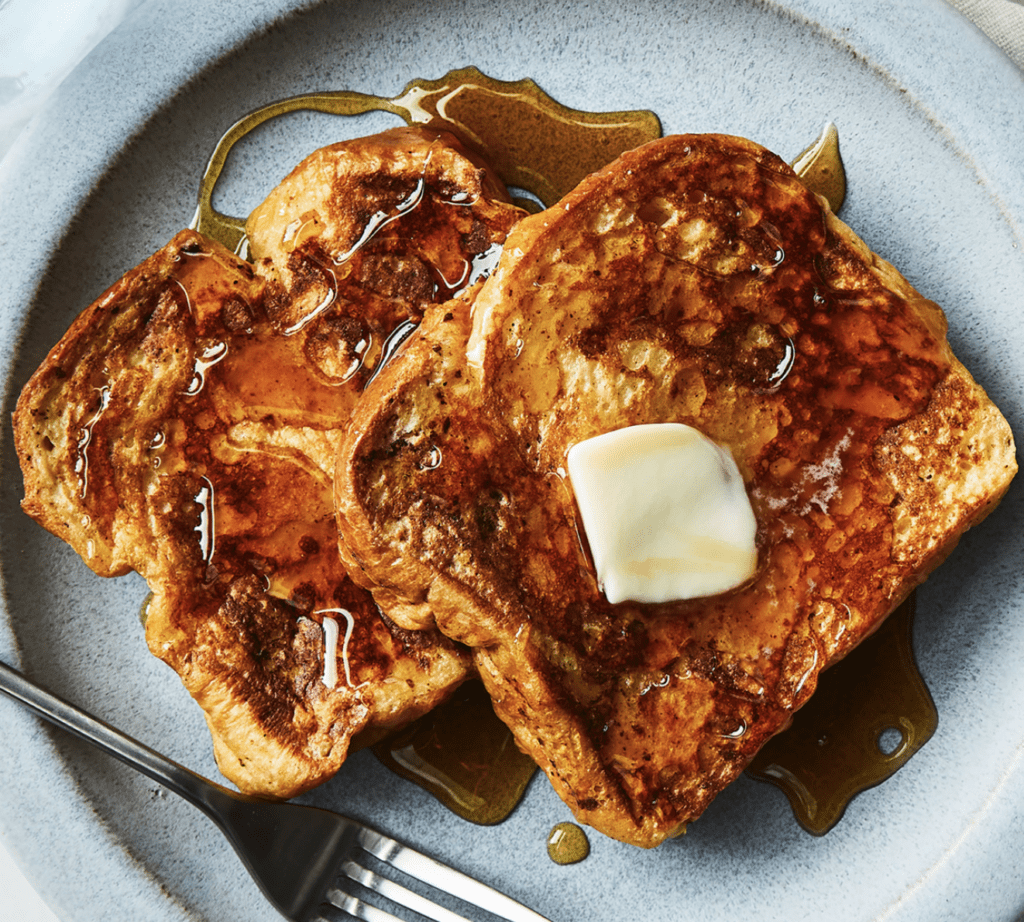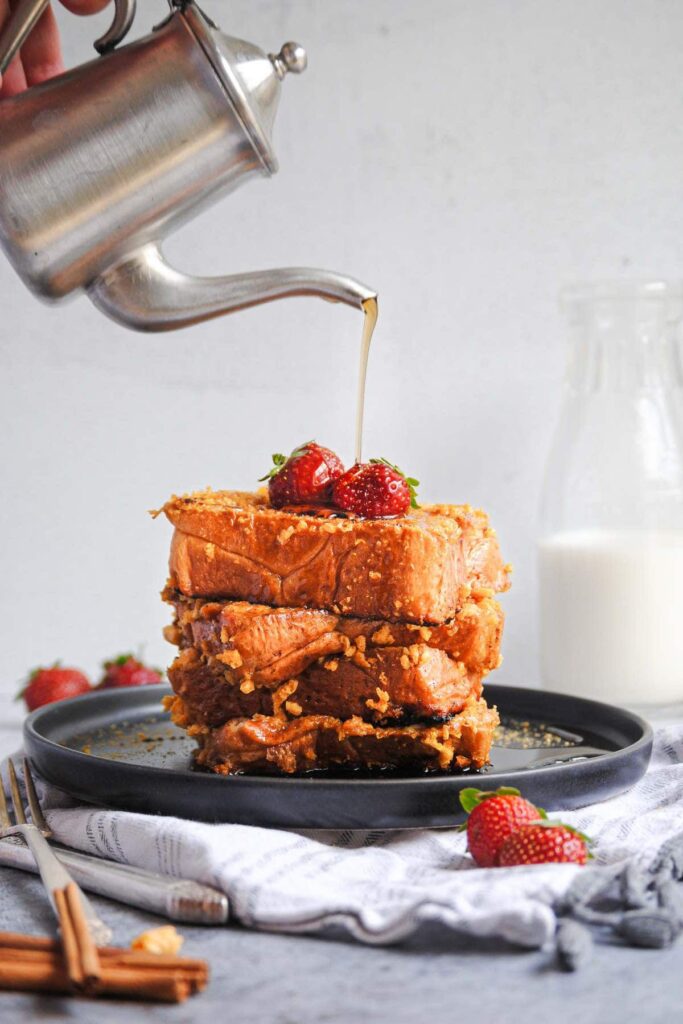Introduction:
There’s something undeniably magical about waking up to the delightful aroma of freshly made French toast filling the air. This classic breakfast dish has stood the test of time, loved by people of all ages and cherished for its simplicity and heartwarming flavors. Whether it’s a lazy Sunday brunch or a special occasion, French toast has the power to transform an ordinary morning into a memorable one. In this blog, we’ll share the best French toast recipe that is not only easy to make at home but also promises to deliver an irresistibly delicious plateful. So, roll up your sleeves, grab your ingredients, and let’s embark on a culinary journey to create the perfect French toast!
Table of Contents
ToggleRecipe:
Ingredients:
- – 8 thick slices of day-old bread (brioche or challah works best)
- – 4 large eggs
- – 1 cup whole milk
- – 2 tablespoons granulated sugar
- – 1 teaspoon pure vanilla extract
- – ½ teaspoon ground cinnamon
- – Pinch of salt
- – Butter or oil for greasing the pan
Let’s Get Cooking:
- In a large mixing bowl, whisk together the eggs, milk, sugar, vanilla extract, ground cinnamon, and a pinch of salt until the mixture is smooth and well combined. The aromatic essence of vanilla and cinnamon will make your taste buds dance with anticipation.
- Preheat a non-stick skillet or griddle over medium heat. While the pan is heating up, take each slice of bread and dip it into the egg mixture, making sure it’s fully coated on both sides. Allow the bread to soak in the mixture for about 20 seconds on each side, ensuring it’s well-infused with flavor but not overly soaked.
- Grease the heated skillet with butter or oil, and place the soaked bread slices on it. Cook each slice until it turns a beautiful golden brown on both sides, with a slight crispness. This process should take approximately 3-4 minutes per side, depending on your stove’s heat level.
- Once cooked to perfection, transfer the French toast to a serving plate. To elevate the taste, you can add a pat of butter, a drizzle of maple syrup, a sprinkle of powdered sugar, or even some fresh berries. The options are endless, so feel free to get creative and customize according to your preferences.
Tips for Variations:
While the classic French toast recipe is divine on its own, you can always play around with variations to suit your taste preferences. Here are a few ideas to get you started:
- Stuffed French Toast: Create a pocket in the bread slices and fill it with your favorite ingredients, such as cream cheese, Nutella, or fresh fruit, before cooking.
- Cinnamon Swirl: Mix some cinnamon and sugar into the egg mixture, and swirl it into the soaked bread slices before cooking for an extra burst of flavor.
- Coconut Lover’s Delight: Replace the whole milk with coconut milk and sprinkle some toasted coconut flakes on top for a tropical twist.
- Savory French Toast: Skip the sugar and vanilla extract in the egg mixture, and instead, add a dash of black pepper and a pinch of salt. Serve it with bacon and a fried egg on top for a delectable savory version.
The Art of Perfecting French Toast:
The foundation of an exceptional French toast lies in selecting the right bread. Thick slices of day-old bread, such as brioche or challah, work best as they absorb the eggy mixture without becoming too soggy. Their soft and airy texture ensures that the finished product is both fluffy and mouthwatering.
The Art of Presentation:
They say we eat with our eyes first, and that couldn’t be truer when it comes to French toast. The key to an appetizing plate is the way you present your creation. Arrange the golden-brown slices with a touch of finesse, and don’t shy away from garnishing with a few fresh mint leaves or a dusting of powdered sugar. The visual appeal will make your French toast even more enticing and enjoyable.
French Toast Recipe - Your Ultimate FAQ Guide
Q1: What is French toast?
A1: French toast is a delicious breakfast dish made from slices of bread soaked in an egg and milk mixture and then cooked until golden brown and slightly crispy.
Q2: What makes French toast different from regular toast?
A2: Unlike regular toast, French toast is soaked in an egg mixture, giving it a custardy and flavorful texture.
Q3: Can I use any type of bread for French toast?
A3: Yes, you can use various types of bread, but thick slices of day-old bread, like brioche or challah, work best for a fluffier result.
Q4: Is French toast difficult to make?
A4: Not at all! French toast is an easy and quick breakfast option that even beginners can master.
Q5: Can I make French toast ahead of time?
A5: While it’s best to enjoy French toast fresh, you can prepare the egg mixture the night before and soak the bread in the morning for a faster cooking process.
Q6: What kind of milk should I use for the egg mixture?
A6: Whole milk works best for a rich and creamy flavor, but you can use low-fat milk or alternative milk options like almond or soy if preferred.
Q7: Can I make a vegan version of French toast?
A7: Absolutely! Replace eggs with mashed bananas or a flaxseed-water mixture, and use plant-based milk for a delightful vegan French toast.
Q8: What spices can I add to the egg mixture?
A8: Ground cinnamon is a popular choice, but you can also experiment with nutmeg, vanilla extract, or even a pinch of cardamom for unique flavors.
Q9: Should I use salt in the egg mixture?
A9: Yes, a pinch of salt enhances the overall flavor of the French toast.
Q10: Can I add toppings to my French toast?
A10: Of course! Popular toppings include butter, maple syrup, powdered sugar, fresh fruits, whipped cream, or even a drizzle of chocolate sauce
Q11: How do I prevent my French toast from becoming soggy?
A11: Ensure the bread is not overly soaked in the egg mixture, and cook it on medium heat until it’s crispy on the outside.
Q12: Can I freeze leftover French toast?
A12: Yes, you can freeze cooked French toast and reheat it in the toaster or oven when needed.
Q13: Is French toast a kid-friendly breakfast?
A13: Absolutely! Kids love the sweet and delightful taste of French toast.
Q14: Can I make French toast in a toaster?
A14: While it’s possible, it’s better to cook French toast on a stovetop for an even and consistent result.
Q15: Can I add a twist to the classic French toast recipe?
A15: Yes! Try adding cream cheese, Nutella, or a fruit compote as fillings for a stuffed French toast variation.
Q16: Is French toast a healthy breakfast option?
A16: French toast can be nutritious if made with whole-grain bread and served with fresh fruits as toppings.
Q17: Can I make French toast for a large group of people?
A17: Yes, you can easily double or triple the recipe to serve a crowd.
Q18: What is the origin of French toast?
A18: French toast dates back to ancient times, with various cultures having their own versions.
Q19: How many calories are in a serving of French toast?
A19: The calorie count can vary based on the ingredients and toppings used. On average, it ranges from 200 to 300 calories per serving.
Q20: Can I make French toast without eggs?
A20: Yes, you can make eggless French toast using alternative ingredients like bananas or aquafaba.
Q21: Can I use stale bread for French toast?
A21: Yes, stale bread works perfectly for French toast, as it absorbs the egg mixture better.
Q22: Can I make French toast with gluten-free bread?
A22: Yes, you can use gluten-free bread to make a delicious gluten-free version of French toast.
Q23: Can I use a flavored bread for French toast?
A23: Yes, flavored bread like cinnamon swirl or raisin bread adds an extra layer of taste to your French toast.
Q24: Can I make a savory French toast?
A24: Absolutely! Skip the sugar and vanilla extract and add herbs and spices for a savory twist.
Q25: Can I use day-old croissants for French toast?
A25: Yes, day-old croissants make for an indulgent and buttery French toast.
Q26: Can I make a healthier version of French toast?
A26: Yes, opt for whole-grain bread, use less sugar in the egg mixture, and add fresh fruits as toppings for a healthier option.
Q27: Is French toast traditionally served with any specific accompaniment?
A27: While maple syrup is a classic accompaniment, French toast can be served with a variety of toppings and sides.
Q28: Can I make French toast in a different shape?
A28: Sure! Use cookie cutters to create fun shapes like stars or hearts.
Q29: Can I use day-old baguette for French toast?
A29: Yes, day-old baguette can be used, but remember to slice it into thick pieces for the best results.
Q30: Can I enjoy French toast at any time of the day?
A30: Absolutely! While it’s a classic breakfast dish, French toast can be enjoyed as a delightful snack or even as a dessert after dinner.
Advantages:
- French toast is a delicious and classic breakfast dish loved by people of all ages.
- It is a quick and easy-to-make breakfast option, perfect for busy mornings.
- Using day-old bread ensures a fluffy and satisfying texture to the French toast.
- The egg and milk mixture gives French toast a rich and custardy flavor.
- French toast can be made with various types of bread, allowing for versatility in taste and texture.
- It’s a great way to use up stale bread, reducing food waste.
- With its simple ingredients, French toast is a budget-friendly breakfast choice.
- French toast can be customized with various spices and flavorings to suit individual preferences.
- It’s a versatile dish that can be enjoyed with both sweet and savory toppings.
- Making French toast in advance by preparing the egg mixture the night before saves time in the morning.
- Freezing leftover French toast allows for easy reheating and minimizes food waste.
- French toast can be made vegan-friendly by using plant-based ingredients, accommodating dietary preferences.
Tips and Tricks:
- For a more decadent flavor, use thick slices of brioche or challah bread.
- Soaking the bread in the egg mixture for about 20 seconds on each side prevents the French toast from becoming soggy.
- Cooking the French toast on medium heat ensures even browning and a crispy exterior.
- Adding a pinch of salt to the egg mixture enhances the overall flavor of the French toast.
- Get creative with spices like ground cinnamon, nutmeg, or cardamom to add depth to the taste.
- Garnishing French toast with fresh fruits, powdered sugar, or whipped cream enhances its presentation and taste.
- For a fun twist, try making stuffed French toast with fillings like cream cheese or Nutella.
- To make it a healthier option, use whole-grain bread and opt for lighter toppings like fresh fruits.
- For a vegan version, replace eggs with mashed bananas or flaxseed-water mixture.
- Use day-old croissants for a buttery and indulgent French toast experience.
- To save time, cook multiple servings of French toast simultaneously on a griddle or large skillet.
- Experiment with different bread varieties, such as cinnamon swirl or raisin bread, for unique flavor combinations.
- For a savory version, skip the sugar and vanilla extract, and add herbs and spices to the egg mixture.
- For a special occasion, use cookie cutters to create fun shapes out of the French toast.
- Serve French toast with a variety of accompaniments like maple syrup, honey, or fruit compote.
- Allow the cooked French toast to cool slightly before serving to avoid burning your mouth.
- To add a tropical twist, substitute regular milk with coconut milk in the egg mixture.
- For a crowd-pleaser, double or triple the recipe to serve a large group of guests.
Conclusion:
French toast is undoubtedly a classic breakfast delight that never fails to bring joy to the table. With this easy-to-follow recipe, you can now master the art of creating irresistibly delicious French toast in the comfort of your own kitchen. The combination of fluffy bread, sweet vanilla, and warm cinnamon will transport you to a world of culinary bliss.
So, why wait for a special occasion to savor this scrumptious treat? Whip up a batch of French toast for your loved ones and watch their faces light up with delight. Whether it’s a lazy weekend morning or a celebratory breakfast, this homemade French toast will undoubtedly become a family favorite. Happy cooking!



